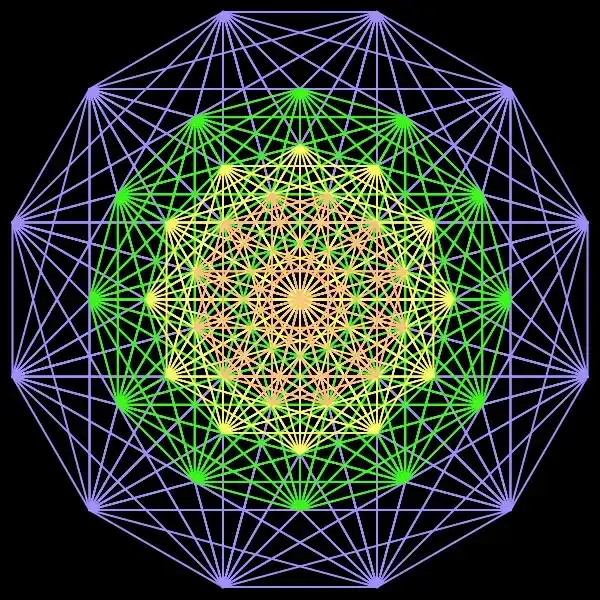Lie Algebras and Groups
USOSLie algebras describe infinitesimal symmetries of physical systems. Therefore, they and their representation theory are extensively used in physics, most notably in quantum mechanics and particle physics. This course introduces semi-simple Lie algebras and the associated Lie groups for physicists. We discuss the essential tools, like the root and weight system, to efficiently work with them and their representations. As on explicit application of the mathematical framework, we discuss Grand Unified Theories (GUT). Moreover, we show how modern computer algebra tools like LieART can significantly help in all explicit computations throughout the course.
 A simple example is the visualisation of the root system of projected on the Coxeter plane, which you can see here. If you want to understand how it is created and connected to particle physics, you should take this course. Basic knowledge of core concepts in linear algebra, like vector spaces, eigenvalues and eigenvectors, is assumed. Some good books about the topic are:
A simple example is the visualisation of the root system of projected on the Coxeter plane, which you can see here. If you want to understand how it is created and connected to particle physics, you should take this course. Basic knowledge of core concepts in linear algebra, like vector spaces, eigenvalues and eigenvectors, is assumed. Some good books about the topic are:
- Fuchs and Schweigert: Symmetries, Lie Algebras and Representations
- Gilmore: Lie Groups, Lie Algebras, and Some of Their Applications
- Fulton and Harris: Representation Theory
- Georgi: Lie Algebras In Particle Physics: from Isospin To Unified Theories
The article Phys. Rep. 79 (1981) 1 by Slansky and the manual of the LieART package are good references, too.
Note: At multiple occasions, we will use Mathematica and it might be a good idea to set it up on your computer. Following the instructions on the main teaching website, you should be eventually able to run the notebook, which generates the projection of the root system above.
Exam: After a majority vote, we decided together that the written exam for this course will take place on Tuesday, the 6th of February 2024, at 13:00 in room 447 (the one where we also have our classes). It will take two hours and you have a practise exam to help you preparing for it. Please be there five minutes earlier such that we can start on time.
Retake Exam: As discussed via email, you have the chance to take part in the retake exam on Thursday, the 15th of February 2024, at 13:00 in room 447. Exactly the same conditions as described for the exam above will apply. If you would like to take part in the retake exam, please send me a quick message via email such that I have an estimated head count and can bring the right number of exams.
Lectures
- Introduction and motivation
- Some mathematical preliminariesLecture10.10.2023 10:15, notes
Unfortunately, there has been some problems with the WiFi in the class room and as a result the recording of the lecture is not usable. Let us hope that it will work better the next time.
- Classical matrix groups
- Cartan subalgebra
- Root system
Sorry for the bad sound quality of the recording. I am working on this issue.
- Simple root and Cartan matrix
- Classification and Dynkin diagramsLecture14.11.2023 11:15, notes
- Irreducible representationsLecture21.11.2023 11:15, notes
Because I mentioned that you can remember the Dynkin diagram of so(8) by thinking of the flux-capacitor from Back to the Future and some of you have not see this movie here is a picutre. For me this is a classic and I highly recommend to watch it when you have not do so yet.
- Highest weight representations
There was a small ambiguity in the Freudenthal formula for the multiplicity. The wedge for "and", looked like the V for vector space. I corrected this one in the notes. You will need this equation for the practise exam. But it is also given there.
- Characters and Weyl group
- Decomposition of tensor products and regular subalgebrasLecture19.12.2023 11:15, notes
- Special subalgebras and branching rulesLecture09.01.2024 11:15, notes
- Particle theory and the standard modelLecture16.01.2024 11:15, notes
- The Georgi–Glashow model

